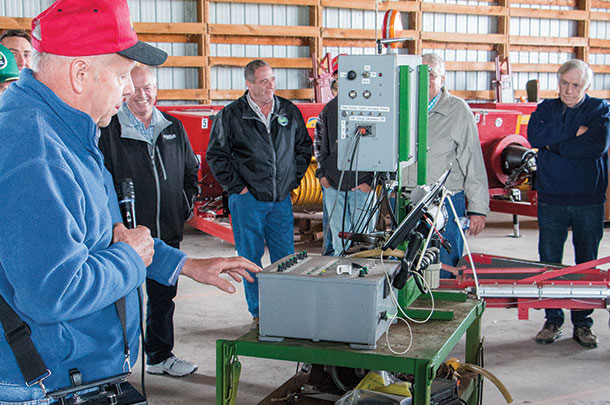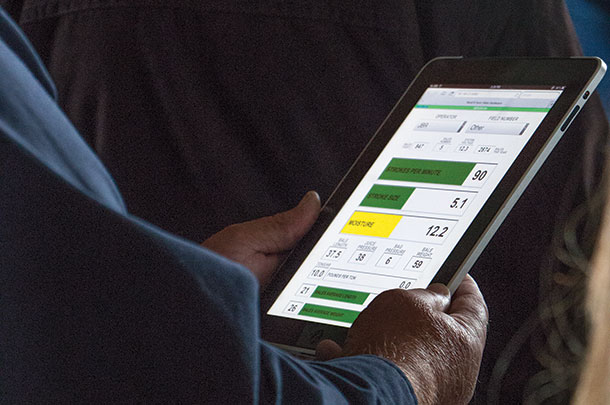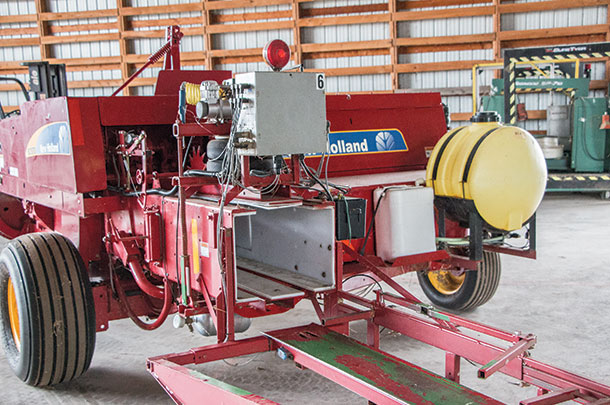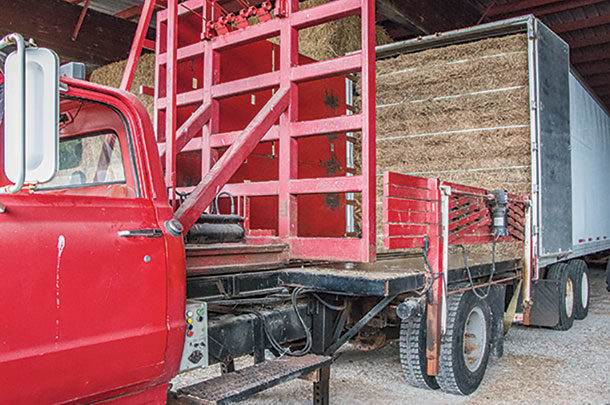If you have an inch error in each bale, those three bales add up to 3 inches too long, and the subsequent stacks are less stable.
John Randall of Randi B Farm in Bloomfield, New York, says, “Some people use stroke counters to monitor the length of the bale, and it feeds that information back to the operator. Ground speed is really what affects the size of the slice or number of strokes in a bale.”
“I tried one of those, but I didn’t think it was fast enough for the operator to change because you had to make one or several bales before you knew whether you were doing it right or not. My goal was to figure out how to gauge the slice so, halfway through a bale, you’d know it was time to slow down.”

Randall wanted an electronic system that would feed information to the operator, who could then adjust speed (among other things) to create consistent bale lengths. He says once a baler decides to tie a bale, it adds one more slice and, if it’s adding a thick slice, then the bale is too long.
His first attempts to trip the bale tying electronically were unsuccessful, and he couldn’t get the baler to compensate for the extra slice. He says, “The plunger has to be in the right position, so once you tell it to ‘trip,’ it still has to finish the cycle. And that one cycle can screw up the length of the bale.”
But that wasn’t the only problem. Randall explains if you want a 36-inch bale, in theory you could say that’s 36 1-inch slices, 18 2-inch slices or 12 3-inch slices. “If you could actually do that, you would think it would come out right, but it will not,” he says.
“You could make a bale, in theory, that has nine 4-inch slices in it and come out with a 36-inch bale, but the reality is: That bale will be longer than the bale with 36 1-inch slices. Don’t ask me why. We beat our heads on the wall trying to figure that out. And anybody will tell you once you start crowding the baler and making the slices too thick, that bale length grows more than that one extra slice.”
In order for a baler to tie strings, the strings have to be slack. Immediately after the knot is tied, the string is loose – you can easily put your hand under it. So once the knot is formed and the plunger relieved, the bale goes out the chamber and expands to fill the space – whatever the string will allow. And strings stretch. When that component is added to the extra-cycle problem, Randall says, “It’s miserable trying to get consistent length out of the small square baler.”
He ought to know. Roughly 80,000 to 90,000 small square bales are made on roughly 1,000 acres each year at Randi B Farm – straight timothy, timothy and brome mixed, or timothy and orchardgrass mixed. It takes six small square balers to keep up with the goal of 100 acres per day of consistently sized bales.
To better address the issue of bale length, Randall came up with an electronic bale monitor similar to what the big balers use. The information collected electronically is transferred via Wi-Fi signal to an iPad or iPhone that shows the operator whether speed of travel is appropriate. It also monitors bale weight, moisture and preservative-applicator rate.

Randall says, “So you get all this feedback, and the idea was that if and when it worked right, it has the capability of adjusting the bale length on the fly by itself.” If another iPad or iPhone user with the program loaded is within line-of-sight and approximately 1,000 feet, the second user can monitor the operation. “We haven’t gotten it so I can sit in the house and monitor what’s happening in the field, but that is potentially possible,” Randall says.
“Someday,” Randall says he’d like to add a GPS component that would pinpoint where each bale was made and identity-preserve each bale, almost like an individual serial number. That data would log where it came from, moisture, weight, length and cutting. While many large balers have that capability, it hasn’t been adapted or developed for small square balers.
Randall used his system about five years and says each year it has been somewhat different. “We started using the iPad relatively early, but each summer you go through and use all the things you made, and each winter you tear them all apart and do them over again to fix all the problems you created for yourself.”
The other modification Randall made to the small square baler was to reduce the bale chamber size so the chamber is actually smaller than the bale needed. While manufacturers may call a baler a 14-inch baler, it will make a 15- or 15.5-inch bale after it expands once it leaves the chamber. Using 4x8 sheets of plastic called UHMW (ultra-high molecular weight) polyethylene, Randall cut it to fit the interior of the bale chamber.

“The trick,” Randall says, “is where you want to bend it. You have to heat it to 300 degrees, and if you get it to 300 degrees, you can read a newspaper through it.”
Most modern van trailers are 98 inches between the posts of the back doors. A block of seven bales times 15 inches won’t fit; however, a block of 14-inch bales will. Although Randall is pleased with the modification and uses it on all six balers, he says, “My warning is: [Modifying the bale chamber] might void your warranty.”
In pursuit of bale-handling improvements, Randall also created a strapping system mounted to his bale wagon that bands a complete bale tier. He says, “I’m banding 21 bales (one full tier) on the bale wagon – nine tiers high. The goal was to strap each tier on the bale wagon as it went up, and we’re sort of there. I can stack nine tiers (a full load) with all the bales running the same way (no cross-turned bales), and it’s stable; it won’t fall over.”
It takes 13 seconds to strap a tier and, during that time, the operator can keep moving through the field to pick up the next three bales to form the next tier, at least when everything works right. Things don’t always work right. “One of the things we found is: When the temperature gets above 90 degrees, the strap changes consistency, and the strapper didn’t work right anymore,” Randall says. “The straps become softer, and they don’t handle the same. One of the problems was: We worked all winter in a barn at 70 degrees to develop it, then you go out in the summer when the temperature raises 20 degrees, and it doesn’t act the same anymore.”
They began by strapping two, three or four tiers in the field per load (depending on how everything was working that day) instead of every tier. The benefit, Randall says, is: “These act like a brick. It’s so much more stable and holds the stack together better. Also, we no longer need to rearrange the tie-tiers when we load out the hay.”
The added advantage is being able to use these strapped blocks to more efficiently load van trailers. Most mechanical loading systems leave air space in the trailer. With a block of 126 bales (seven bales wide by six bales high by three bales long), Randall can use a hydraulically driven pusher (which, yes, he also designed and built) to load a total of 714 bales per van (five full blocks and a block of 84 – two bales long – for a total of 17 37-inch-long bales in the trailer) with virtually no wasted space.
That is, 714 bales can be loaded with less than 4 inches of headspace if the all-critical bale length is correct. If it isn’t correct, the van doors won’t shut. And that’s why innovation at Randi B Farm happens one bale at a time. ![]()
PHOTO 1: This hydraulic hay pusher loads van trailers with 714 bales – if they’re correctly sized. The strapped tiers help stabilize each block of 126 bales.
PHOTO 2: Randall’s bale monitor indicates whether speed of travel is appropriate to achieve the right bale length.
PHOTO 3: It also monitors bale weight, moisture and preservative-applicator rate, and transmits data to the operator’s iPad or iPhone.
PHOTO 4: In a quest to achieve correct bale size and make adjustments mid-bale, balers were modified with monitors to feed data to the operator, and the bale chamber size was reduced. Photos by Lynn Jaynes.
To see the strapper in motion, go to Strapper v3
To see the hydraulic pusher in motion, go to RandallWay Loading.
To see more photos of Randall’s equipment, view the slideshow.
Read about Randall’s plungerless baler design.

-
Lynn Jaynes
- Editor
- Progressive Dairyman
- Email Lynn Jaynes
Another modification
One other modification John Randall made to his small square baler was to add 50 percent more weight to the flywheel.
Some history: When Randall had a different baler one of his problems was breaking a lot of flywheel shear bolts, and unfortunately that particular brand of baler can continue to bale even with a broken shear bolt. The last year Randall ran those balers he used nearly 200 shear bolts. Randall’s original bale monitor included a shear bolt monitor.
The first year Randall switched to the New Holland balers his crew had trouble tearing up the slip clutches, especially on the balers pulled behind the two bigger tractors. (He normally uses four 70-horsepower tractors and two 125-horsepower tractors to run the balers.)
Randall says, “We also felt that the smaller tractors were a better fit for the balers because the engines will ‘give’ a little on each compression stroke of the baler and, after talking around, we decided maybe the newer electronic fuel-injected tractors were responding faster (too fast) to the added load of the compression stroke and revving up at exactly the same time as the plunger was slowing down, and thus the slip clutch had to give (or slip).”
To compensate, Randall tried adding about 100 pounds to the (about 200-pound) flywheel so it would have more energy to put into the compression stroke. “The difference,” he says, “was so impressive we went ahead and modified the other four balers the same way. Not only did our slip clutch problem go away, but the driveline on all six balers does not flop around on each plunger stroke as they did before; the balers just run so much smoother and quieter.”











